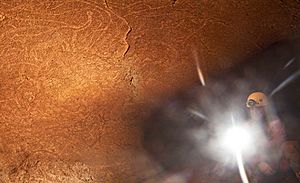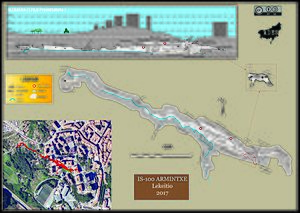Armintxe Cave facts for kids
Quick facts for kids Armintxe Cave |
|
|---|---|
| Location | Lekeitio, Basque Country, Spain |
| Visitors | no |
| Features | prehistoric parietal art |
Armintxe Cave is a very important place in Lekeitio, Spain, known for its amazing ancient rock art. This art was made during the Paleolithic period, which was a very long time ago – about 12,000 to 14,500 years ago!
Contents
Where is Armintxe Cave?
Armintxe Cave is found in the town of Lekeitio. This town is in the Biscay province, which is part of the Basque Country in northern Spain.
How Was the Cave Found?
People knew about Armintxe Cave a long time ago. But later, many thought it had disappeared because of new buildings and construction work in the late 1900s and early 2000s.
Luckily, on May 1, 2016, a group of eight cave explorers from a Basque group called ADES Espeleologia Elkartea found it again! They opened up the entrance, which was on a hillside right in a town area. The explorers went into parts of the cave no one had seen before. They squeezed through a tight spot and entered a room where they discovered the incredible panel of engravings.
Amazing Rock Art
The cave is famous for its prehistoric art, which means art made by people from a very long time ago. This art is called "parietal art" because it's found on the walls of the cave.
What Makes the Art Special?
Some of the art styles and the way the etchings were made look exactly like art found in the French Pyrenees mountains. This suggests that people from these two areas might have been connected long ago. Experts have called this art a "treasure of humanity."
The pictures are very large, with some reaching up to 1.5 meters (about 5 feet) long. A big surprise was finding the first images of two lions from the Paleolithic period in this region.
What Can You See?
The main art panel is beautifully carved with many animal figures. They are arranged in a complex way, almost like they are showing depth or perspective. All the pictures were made using the same method: scratching the soft limestone rock with fingers or a dull tool. This created very detailed figures that are easy to see.
The animals are shown with great detail, which is typical of the Magdalenian art style. You can see horses, bison, ibex (a type of wild goat), and some meat-eating animals. One of these meat-eaters is believed to be a lion, which is rare in Magdalenian art. There are also several signs, including clear "claviforms" (club-shaped symbols). The way the animals are drawn and the presence of these symbols suggest the art is from the Late Magdalenian period.
Can You Visit?
Armintxe Cave is not open to the public. It's very hard to reach, and it's located right under a residential building in Lekeitio. Because the paintings are so important and fragile, it's not possible to let people visit them right now. This helps keep the artwork safe.
Protecting the Cave
The cave has a big problem with flooding. This is because building and city development have changed how the underground river flows. When the cave floods, it can damage the amazing art inside. Some art has already been harmed, and there's a risk that all of it could be destroyed.
To fix this, explorers need to finish mapping the cave to understand how the water moves through the underground karst system. However, this exploration is currently stopped because of disagreements between the government, archaeologists, and cave explorers.
See Also
 In Spanish: Cueva de Armintxe para niños
In Spanish: Cueva de Armintxe para niños
- Caves of Midi-Pyrénées
- Cave of Niaux



